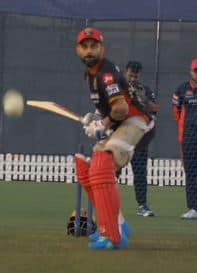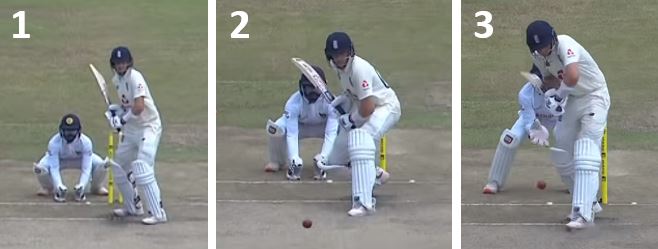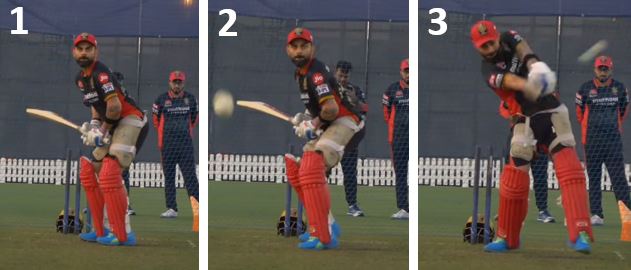When I was in my early cricket playing days, I read a lot of autobiographies of cricketers that played for England during the era where Duncan Fletcher was the coach. Many of them mentioned how Fletcher always pushed batsmen to use the forward press – especially when batting against spinners! Because I was a young player at the time and seeking out ways to improve, I thought I’d try to learn more about the forward press to add it to my game. However, I remember not being able to find much info about what it was – or why it was good for batsmen to use!
So, if you’ve heard about the forward press and you’re wondering what it is or how it can benefit your batting technique, make sure you read this post! As well as telling you all of that, we’ll do some case studies and look at some examples of professional batsmen using the forward press. Plus, I’ll share some drills that will help you add it to your game, if that is the route you want to go down!
What Is The Forward Press?
The forward press is the name given to the small forward movement that a batsman will make just before they receive a delivery from a bowler. It usually involves the batsmen taking a half-step down the pitch with their front foot and getting their weight going forwards towards the bowler. Movements like the forward press that take place just before the bowler delivers the ball are commonly referred to as ‘trigger movements’, and they are used to get the batsman into a good base position from which they can react to the ball quickly! The forward press is just one of a number of different trigger movements that batsmen can choose to use.
The forward press is used mostly against spin bowlers. The first reason for this is that it is generally a lot easier to play spin bowlers off the front foot. The second reason is because spinners bowl much slower than fast bowlers. This slower speed means that batsmen can afford to commit to the front foot by using the forward press, because they have a little more time to adjust the position of their feet if the ball turns out to be short. It is much harder to make this adjustment against quick bowlers because of the speed of the delivery! However, many batsmen also like to use the forward press against fast bowling too.

Why Do Batsmen Use The Forward Press?
So, now you know what the forward press is, you may be wondering why batsmen choose to do it. What can they possibly gain from it? Well, as I’ve already hinted at – the forward press is great for getting batsmen into athletic positions from which they can easily and quickly move forwards or backwards. This means they can use the forward press to get into their athletic position, then watch the ball and try to pick the length quickly. Once they have picked up the length of the ball, they can decide whether to take another half-step forward and play the ball on the front foot or push back and play the ball off the back foot.
Your next question may be – what is it about the forward press that makes it easier for the batsman to move forwards or backwards? The answer to this is pretty simple, and it’s best explained with an example…
To start with, let’s imagine that you have used the forward press and taken a half-step down the pitch with your front foot, and got your weight leaned slightly forward over your front knee. Once in this position, your task is to pick up whether the ball is full or short. If you notice the ball is going to be full, you don’t have to move your front foot much further forward down the pitch because you’ve already moved it slightly during the forward press. Therefore, you’ve basically cut down a little bit of the distance that your front foot would have had to move if you’d stayed in your original stance! If instead you notice the ball is going to be short, it is incredibly easy to push quickly backwards off your front foot and play a back foot shot.
Now imagine that you’re batting and your weight is over your back foot. From here, it may be easy to play back foot shots, but you’ll find that it’s quite difficult to come forwards quickly and play effective front foot shots. Players who start with their weight over their back foot will often end up lunging at the ball, rather than letting it come to them and playing it late.
I’ve heard many professional players say ‘it’s easier to come forwards and then go back, than it is to hang back and then come forwards’. This is the perfect encapsulation of why the forward press is loved by so many batsmen! It allows them to get themselves a bit closer to the pitch of the ball if the ball is full, but it also allows them to transition very quickly to the back foot if the ball is dropped short.
If you’re unsure about this and it seems a little too good to be true – I’d recommend trying it yourself! Start with your weight over your front foot as if you’ve just don’t the forward press, and then practice moving forwards and backwards as quick as possible. Then start with the majority of your weight over your back foot and do the same thing. For me, it’s clear that it’s much easier to start with your weight forwards and then adjust to a short ball than it is to do the opposite!
Professional Cricketers Using The Forward Press
Now that I’ve explained what the forward press is and why it’s so useful, I should probably show you what it looks like! In this section we’ll look at a few examples from top cricketers – starting with Joe Root! Joe is an excellent player of spin and he uses the forward press expertly when playing against spin bowling.
In picture 1 below, you can see Joe is in his usual batting stance for facing spin. His back foot is in line with middle stump and he is stood in a slightly open stance, with his back foot slightly outside leg stump. Just as the bowler delivers the ball, Joe moves into the position shown in picture 2. Here, his back foot has stayed in the same position, but he has moved his front foot a half-step down the pitch, and brought it across to the middle stump. His front leg is now slightly bent, and his weight is now slightly more centred over that leg. This is the forward press in action! In picture 3, Joe has picked up that the ball is full, and he’s decided on playing the sweep shot. As soon as he notices the ball is full, his front foot moves further out to the pitch of the ball, and he prepares to play the sweep. From this example, you can see that the forward press helped Joe to get his front foot into position quicker!

Now for the next Joe Root example! In the pictures below you can see him reacting to a ball that is slightly shorter than the first set of photos. Photo 1 again shows Joe in his usual, slightly open batting stance. In picture 2 you can see the forward press in action! Joe has pushed slightly forwards on to the front foot, and his weight is now over the front leg. Once he notices that the ball is short enough to play off the back foot, he quickly pushes backwards off his front leg and ends up in the position you can see in picture 3 – ready to whip the ball smartly in to the leg side.

My next example is Virat Kohli – another excellent player of spin bowling. He’s a guy I always look at if I want to find examples of great batting footwork. In picture 1 below you can see Virat batting in one of his most common stances against spin. It’s also very similar to Joe Root! He has a slightly open stance, with his back foot on middle stump and his front foot slightly outside the leg stump. As the ball is delivered Virat uses the forward press – you can see this in picture 2. He’s taken a small step forward with his front foot and has his weight positioned slightly more forwards over his bent front knee. In between picture 2 and picture 3 Virat notices the ball is going to land short, so he pushes back off his front foot and swivels in order to play the pull shot you can see in picture 3!

My last example is Jonny Bairstow! Jonny excels playing against spin – particularly in the shorter forms of cricket. In picture 1 below you can see that Jonny starts in a very upright stance, with his back foot on middle stump and his front foot on leg stump. As soon as the ball is released, he uses the forward press to get into the position you can see in picture 2. This is a much more athletic position and is very similar to the ones I’ve already showed you above! He is now more crouched with his weight over his bent front knee, and he’s taken a small step down the wicket. When he picks up that the ball is going to be full, he pushes his front foot slightly further down the pitch towards where the ball is going to land and launches into a powerful cover drive. You can see Jonny halfway through the shot in picture 3!

My Favourite Drills For Practicing The Forward Press
There are a few easy ways to practice the forward press so that you get comfortable doing it. I’ll take you through them in the section below.
Shadow Batting & Visualisation
If you’re not sure what shadow batting is then allow me to briefly explain! Shadow batting is what batsmen are doing when they are rehearsing their movements and their shots whilst not facing any deliveries from a bowler. You’ll often see batsmen warming up by shadow batting before they get out to the middle. I think it’s a great way to get your feet moving and to get comfortable with the movements you make.
To practice the forward press using shadow batting, all you have to do is imagine you are facing a real bowler. Get into your usual batting stance, and then visualise the spinner running up. As they are about to release the ball, rehearse your forward press movement, and then rehearse the movement of going back onto the back foot, or pushing forward even more onto the front foot.
Practicing the forward press in this way is great for batsmen who aren’t too familiar with it because it helps them ingrain the movements into their muscle memory! If you’re new to the forward press, I’d definitely recommend practicing it in this way quite regularly when you first begin.
Isolating Press Movement
What you’ll need for this drill: A small hurdle – or a set of them like the ones I’m linking to on Amazon here! If you don’t want to spend money on something, you could try to find something else that you can jump over. The hurdles like the one I just linked to are great because they’re not too high, and they wont cause too much of a hazard if you hit your feet on them due to them being flexible. If you’re going to use something else, make sure it’s not too tall or bulky.
Optional items: A cricket bat, a cricket ball, a partner to throw the ball to you.
How to perform the drill:
- Place your hurdle in front of you, and then get into a side on position which is similar to your batting stance. If you’re a right handed batsman, you left foot will be closer to the hurdle. The opposite is true for left handed batsmen. When you’re in position, you should be around 10 centimetres away from the hurdle.
- Now, jump sideways over the hurdle with your leading foot and land on that same foot, keeping your trailing foot in the air. Landing on one leg in this way is a test of strength and balance! Maintain your side-on position throughout the jump and the landing.
- Once you’ve landed over the hurdle on your front foot, jump backwards back over the hurdle and land back in your original stance. Again, you should stay in your original side-on position throughout this process.
- Repeat these jumps as many times as you like.
If you find it hard to follow these steps, the process of the drill is shown in the video below!
I like this drill because it helps prepare your body for swift movements forwards and backwards, which is what the forward press is all about. The explosive nature of the drill also helps to increase the strength of your quadriceps muscles, which are vital for being able to move backwards quickly if the ball is short in length. As the video above shows, you can introduce a bat if you want, and even have someone throw the ball to you to practice playing a shot once you have performed your jumps.
Face Plenty Of Bowling In The Nets
If you really want to add the forward press to your game, there’s no better way to do so than to practice it against real bowlers in the nets. Doing this helps you to sync up the timing of your movements with the bowlers movements, and allows you to develop a good batting rhythm.
I’d recommend facing bowlers in the nets for at least one hour per week if possible, but ideally you should be trying to spend more time in the nets than that – especially when you’re trying to develop a new skill like the forward press. Technical changes and additions require repetition in order to master, so you’ll have to spend plenty of time practicing it before it will feel like second nature to you.
If you only want to use the forward press against spin bowlers, then make sure you have a spin bowler to practice against. Or, get someone to give you slower throw downs so that you can rehearse the movement against the right speed of bowler. If you want to use the forward press against both fast and slow bowlers, then make sure you practice it extensively against both. The change in speeds requires you to move in slightly different ways, and this is something you will have to get comfortable with through practice!
Final Things To Remember
I’d like to close out this post with some final thoughts:
- Keep your head and eyes level while you perform the forward press, and keep your eyes focused on the ball. You shouldn’t be thinking about where you feet are going to land as you perform it.
- Don’t move too early – batsmen who do so will end up ruining the timing of their shots more often than not. Practicing in the nets helps you develop a feel for when you need to start your movements
- Make sure your forward press is not too large – batsmen who take a huge stride during their forward press are usually not going to be successful. The bowler will notice this and begin to exploit it, and you will also find it much harder to react to shorter deliveries. Taking a half step towards the bowler is all you need to do, as I showed you with the examples of Root and co earlier in the post!
- Don’t feel like you have to add the forward press to your game – some batsmen don’t use it, and that is totally fine! If you feel like it’s something that will work for you, feel free to start practicing it, but if not – don’t worry!
